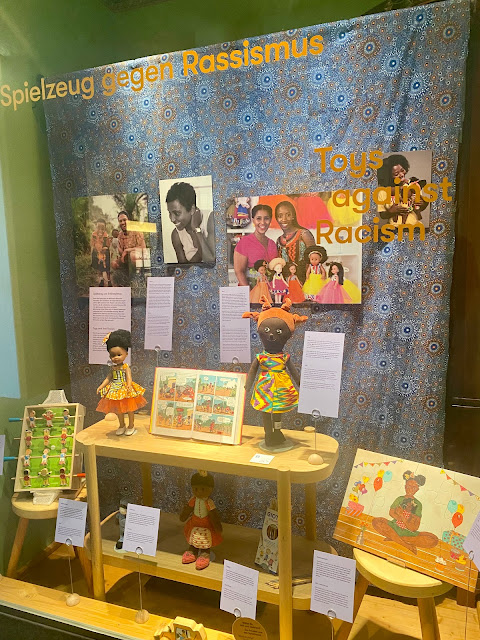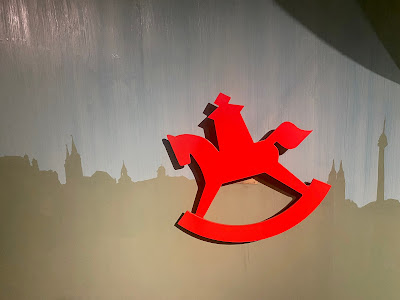I'm around three in my earliest memory, playing with a wind-up toy car in the Frankfurt airport, en route back to the United States after living in Munich for nearly three years. During one of the Christmases we spent there, my father bought me a little steam engine that I kept for my entire childhood. I had a hunch that I'd find examples of both in Nuremberg's Toy Museum.
Voila!
I barely could contain my excitement, perhaps because I'd kept my expectations low. When I asked the innkeeper at the Smile Hotel if the museum was worth visiting, she had sneered "Why bother? All toys are made in China now." But back in the 50s, Schuco, a German company, still manufactured cars using metal and rubber as it had been doing since the 30s. They came with a t-shaped key or at least mine did. It looks as if there may have been less expensive models, too, more like the Matchbox cars produced in the United Kingdom and exported to America in the 1950s.
My steam engine was on the smaller side but I vividly remember the red spoke wheel and the little white tablet that you ignited before placing it with tongs in the furnace beneath the shiny steel water cylinder. Probably not the smartest present for a three-year-old, but Dad loved to buy me gifts that he could play with, too. Including the dune buggy that saved me from bullying in high school.
When you're an only child, your toys (and your books) are really important. This painting, also on display in the wonderful museum, whimsically captures the privilege and occasional loneliness especially when you're new in town, or living in a country where you don't speak the language. By the time I went to high school, we had moved six times.
 |
| "Only Child" by Gerhard Glück (2006) |
But the delightful museum has a lot more to recommend it than my particular brand of nostalgia. Before I purchased a ticket, I asked the guy at the front desk if I'd find an historical collection of toys. "That's exactly what this is," he replied with a note of exasperation. Many--including a timeline of toy production--are imaginatively exhibited in the ground-floor gallery that recreates Nuremberg, once considered the world capital of toys and still the site of an annual, international toy fair. "Nuremberg Means Toys" is a tourist slogan with a greater basis in reality than "Way of Human Rights."
This doesn't look like any Scrabble game I've ever seen. German words are longer, use more Zs and fewer Ys, and occasionally require umlauts which apparently increase the value of vowels!
The significance of the brightly painted bottle caps eluded me unless it was a nod to DIY toy making.
Turkish toys were the focus of a temporary exhibit. Turks, who make up 2.5% of Germany's population, comprise its biggest minority group.
I stopped on the staircase to change the heads, midsections and lower extremities of five different figures on a series of cylinders, each with three rotating parts.
Call it paper dolls re-conceived by Salvador Dali. I'd played with something similar at the Budapest History Museum which depicted changing bathing suit styles.
The second floor gathered toys by type.
One surprisingly au courant case was called "Toys against racism."
But this doll, on exhibit nearby, looked as it might be perpetuating racial stereotypes.
Toys, like people, have been gendered for centuries. Apparently, incredibly detailed dollhouses were the "must have" among little Fräuleins in the nineteenth century.
In addition to cars and steam engines, I think I may have had an Erector set, or at least played with one at a friend's house. Lincoln Logs, a uniquely American product, were more my speed. No nuts, bolts or wrenches required.
An adult-oriented exhibit on the third floor took a brilliant look at German history since World War II through the lens of toy production. During the "Rubble Years" children played with whatever they could get, which wasn't much.
German manufacturing, severely restricted after the country's defeat, permitted the export of metal toys to the United States as a desperately needed cash generator. But toys for native children could be made only of wood, cloth and paper.
As rebuilding accelerated with the promise of "Affluence for Everybody," toy makers reflected its progress in the nursery. The "Brick by Brick" case could have been a set for The Marriage of Maria Braun, Rainer Werner Fassbinder's melodramatic examination of the German economic miracle and its emptiness.
Everything old is new again. Ken & Barbie-type dolls make an appearance in another case depicting the disposable income era with outdoor recreation on German camping trips. Van Life, any one?
For a little more than an hour, I felt a distinctly childish sense of wonder, as if I had been ripping open the Christmas presents of my youth again.
More Bavaria:























No comments:
Post a Comment